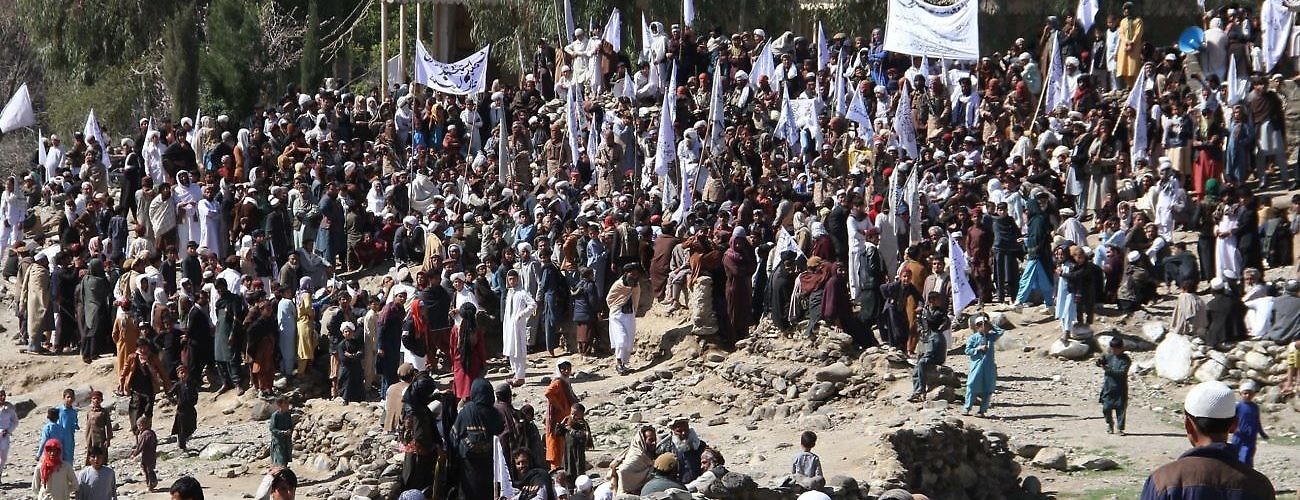Taliban fighters and villagers celebrate the peace deal signed between the US and Taliban in March 2020. (Wali Sabawoon/NurPhoto via Getty Images)
The new proposal by the United States for ending the war in Afghanistan outlines an ambitious process of international, regional, and national diplomacy. As presented to government officials in Kabul and Taliban negotiators in Doha, the draft plan calls for a United Nations-hosted international conference, a support group of regional governments along with Russia, China, and the US, and direct talks between the Afghan government and the Taliban. The goal is to establish an interim transitional authority that includes Taliban representation, a ceasefire agreement, and a roadmap for creating a new government to define the country’s political future.
The new proposal comes as the administration of US President Joseph Biden faces a May 1 deadline on whether to withdraw the remaining US troops from Afghanistan. US Secretary of State Antony Blinken has written a firm letter to Afghan President Ashraf Ghani, who has previously opposed an unelected interim authority, urging him to “strongly consider” the proposal for a power-sharing settlement, pointedly stating that the option of US withdrawal “remains on the table.”
It is uncertain how the Afghan government and the Taliban will respond to the new US proposal, but the basic elements of the plan are sound. Experiences from other successful peace processes indicate the importance of international support missions, power-sharing arrangements, and transitional dispute resolution mechanisms.
Missing from the new plan, however, is a formula for establishing interim security arrangements during the transition period. Experience from peace processes in Cambodia, Bosnia, Côte d’Ivoire and other countries indicates that third party security guarantees as part of a comprehensive peace mission are essential for successfully ending internal armed conflicts.
The strategy for ending the war should include the creation of an Interim International Security and Peacekeeping Force (IISPF). The proposed force could be authorized at the UN-sponsored international conference as part of multidimensional peace mission.
The functions of an interim security force might include: managing and monitoring ceasefire provisions; providing security and police protection during the transition period as US and NATO combat troops depart; and helping to create new integrated Afghan security forces that are able to build trust in local communities and protect the safety and human rights of minority groups and women.
Cultural awareness is recognized as the key factor in effective peacekeeping missions. The credibility and cultural sensitivity of the proposed security force in Afghanistan would be greater if it is composed of troops from neutral third-party Muslim-majority countries such as Indonesia and Bangladesh. Officials of the Taliban previously proposed replacing US troops with Muslim peacekeepers and pledged not to attack such a force.
The recommended IISPF would need to operate under UN authority to ensure international support. Countries will only contribute troops to a peacekeeping force authorized by the UN Security Council. The force would operate for a limited period until the completion of the transition process and the creation of a new governmental system and integrated Afghan security and police forces.
Evidence from post-conflict experiences in many countries indicates that peace processes are more likely to succeed when they are supported by international peace missions and third party peacekeeping forces, while those without external support and security protection often fail. Post-conflict transitions with UN peacekeeping support increase the chances of durable peace and inclusive democratic processes.
The US and its NATO allies should agree to help fund the interim force and provide equipment, logistical support, and training. Command of the force could be with officers of the Muslim-majority troop-contributing countries, following the UN peacekeeping model. NATO and the US could then help create, equip, and train new integrated Afghan security forces.
It is important to develop plans for interim security arrangements now, so that security issues are on the table in the negotiating process. The prospect of a third party force to monitor and enforce a negotiated agreement could improve the chances of a successful outcome. It would increase confidence that peace agreement commitments are implemented and offer the promise of protection during the fragile post-settlement period.
The alternative to a negotiated peace agreement and new security arrangements is a continuation of the present war with its devastating human consequences. The Kabul government is divided, corrupt, and ineffective, and incapable of defeating the Taliban, which controls half the country and by some accounts is gaining ground. It is better to seek a power-sharing agreement now than lose this opportunity and risk the return to intensified civil war and a new reign of terror.
There are no easy solutions, but to avoid a much larger security challenge in the future, the prudent course now is to pursue a power sharing agreement with third party security support. The addition of an IIPSF to the current proposal would improve the chances for Afghanistan, the international community, and the US to establish peace with security.
David Cortright is Director of the Global Policy Initiative at the University of Notre Dame’s Keough School of Global Affairs. Madhav Joshi is Associate Director of the University of Notre Dame’s Peace Accords Matrix, the world’s largest source of peace accord implementation data.





